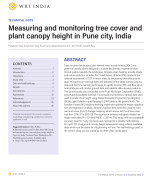Measuring and monitoring tree cover and plant canopy height in Pune city, India
by , , e -Global datasets often fall short in estimating tree cover areas outside the forest tracts, particularly in urban areas. This limitation poses a challenge for accurately estimating tree cover outside forests (ToF) and understanding their contribution to ecosystem services. In the context of increasing population pressure and unsustainable urbanization in Indian cities, regional-level tree cover and canopy height estimations are crucial for evaluating the impact of ToF on various ecosystem services, including carbon sequestration, climate change adaptation, biodiversity hotspots, groundwater recharge, soil conservation, flood control, urban heat mitigation, and psychological and emotional well-being. This technical note outlines a rapid and cost-effective methodology for assessing tree canopy cover and height, specifically tailored for ToF estimation, offering a valuable tool for addressing these socio-urban environmental challenges and enabling sustainable land use planning.
This technical note demonstrated a robust approach for assessing green infrastructure through tree outside forest (TOF) change monitoring in the Pune Municipal Corporation (PMC) area. The methodology leverages the publicly available temporal satellite optical and microwave imageries and AI-based image classification techniques to estimate tree-dominated areas. Further, the study employed LiDAR waveform-driven data to estimate tree canopy height, a proxy indicator of aboveground carbon stock in trees.
The generated datasets can help resource managers and conservationists monitor land use changes and provide important data for planning and management practices. Furthermore, this approach is scalable and can be applied to other landscapes, offering a reliable methodology for rapid and periodic TOF change mapping and canopy height estimation with limited resources.


